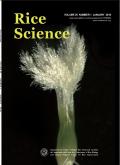不同降水年型下水稻产量和氮素命运对地被水稻生产系统的模拟响应
IF 5.6
2区 农林科学
Q1 AGRONOMY
引用次数: 0
摘要
地膜水稻生产系统(GCRPS)在保障丘陵地区水稻生产方面具有相当大的潜力。然而,在不同的降雨条件下,其对产量和氮(N)命运的影响仍不确定。在中国西南丘陵地区四川省资阳市进行了为期两年的田间试验(2021-2022)。试验采用常规淹水水稻(paddy, W1)和GCRPS (W2)两种栽培方法。这些方法与3种氮肥管理方法相结合:N1(无氮肥)、N2 (W1和W2均以135 kg/hm2尿素作为基肥)和N3 (W1分别施用135 kg/hm2尿素,W2分别施用67.5 kg/hm2尿素和鸡粪)。对土壤水热碳氮模拟器(WHCNS)模型进行了标定和验证,模拟了池塘水深、土壤储水量、土壤矿质氮含量、叶面积指数、地上干物质、作物氮吸收和水稻产量。随后,利用1980 ~ 2018年的气象资料,利用该模型模拟了不同降水年份下水稻产量和氮素命运对GCRPS的响应。结果表明,WHCNS模型能较好地模拟水稻和GCRPS的作物生长和氮素命运。与水稻相比,GCRPS减少了所有降水年类型的N淋溶(35.1% ~ 54.9%)、氨挥发(0.7% ~ 13.6%)、N径流(71.1% ~ 83.5%)、反硝化(3.8% ~ 6.7%)和总N损失(33.8% ~ 56.9%)。然而,在丰水年,GCRPS降低了作物的氮素吸收和产量,而在干旱和正常年,GCRPS增加了作物的氮素吸收和产量。施肥降低了丰水年水稻产量的稳定性和可持续性,但增加了干旱年和正常年水稻产量的稳定性和可持续性。综上所述,GCRPS更适合于研究区域的正常年和干旱年,可以提高水稻产量,减少氮素损失。本文章由计算机程序翻译,如有差异,请以英文原文为准。
Simulating Responses of Rice Yield and Nitrogen Fates to Ground Cover Rice Production System under Different Types of Precipitation Years
The Ground Cover Rice Production System (GCRPS) has considerable potential for securing rice production in hilly areas. However, its impact on yields and nitrogen (N) fates remains uncertain under varying rainfall conditions. A two-year field experiment (2021–2022) was conducted in Ziyang, Sichuan Province, located in the hilly areas of Southwest China. The experiment included two cultivation methods: conventional flooding paddy (Paddy, W1) and GCRPS (W2). These methods were combined with three N management practices: N1 (no-N fertilizer), N2 (135 kg/hm2 urea as a base fertilizer in both W1 and W2), and N3 (135 kg/hm2 urea with split application for W1 and 67.5 kg/hm2 urea and chicken manure separately for W2). The WHCNS (Soil Water Heat Carbon Nitrogen Simulator) model was calibrated and validated to simulate ponding water depth, soil water storage, soil mineral N content, leaf area index, aboveground dry matter, crop N uptake, and rice yield. Subsequently, this model was used to simulate the responses of rice yield and N fates to GCRPS under different types of precipitation years using meteorological data from 1980 to 2018. The results indicated that the WHCNS model performed well in simulating crop growth and N fates for both Paddy and GCRPS. Compared with Paddy, GCRPS reduced N leaching (35.1%–54.9%), ammonia volatilization (0.7%–13.6%), N runoff (71.1%–83.5%), denitrification (3.8%–6.7%), and total N loss (33.8%–56.9%) for all precipitation year types. However, GCRPS reduced crop N uptake and yield during wet years, while increasing crop N uptake and yield during dry and normal years. Fertilizer application reduced the stability and sustainability of rice yield in wet years, but increased the stability and sustainability of rice yield in dry and normal years. In conclusion, GCRPS is more suitable for normal and dry years in the study region, leading to increased rice yield and reduced N loss.
求助全文
通过发布文献求助,成功后即可免费获取论文全文。
去求助
来源期刊

Rice Science
Agricultural and Biological Sciences-Agronomy and Crop Science
CiteScore
8.90
自引率
6.20%
发文量
55
审稿时长
40 weeks
期刊介绍:
Rice Science is an international research journal sponsored by China National Rice Research Institute. It publishes original research papers, review articles, as well as short communications on all aspects of rice sciences in English language. Some of the topics that may be included in each issue are: breeding and genetics, biotechnology, germplasm resources, crop management, pest management, physiology, soil and fertilizer management, ecology, cereal chemistry and post-harvest processing.
 求助内容:
求助内容: 应助结果提醒方式:
应助结果提醒方式:


